|
It’s no secret that bees are in decline due to intensive farming methods that have seen 97% of our ancient wildflower meadows disappear since the 1930’s. Wildflower strips on farmland are helping, but gardeners can do their bit too and late-summer flowers help enormously because lots of solitary bees and bumble bees are feeding their broods. They’re after two things. Pollen, a protein-rich substance for breeding and nectar, the the energy drink for flight. Nectar flows best in warm, sunny positions so, if you want bees, plant in the sunniest positions possible.
Nectar is a sugar-rich substance, but it varies greatly from plant to plant when it comes to composition. The two extremes are the Crown Imperial (Fritillaria imperialis) which only has 8% sugar and marjoram (Origanum vulgare) which weighs in at a full 76%. It’s no surprise therefore that bees and butterflies go for full strength nectar whenever they can. It provides more energy. You could plant a French marjoram, such as Origanum onites or sow seeds of Origanum vulgare, and use the leaves in the kitchen, or on the edge of a vegetable garden.

The best origanum for the flower border is Origanum laevigatum ‘Herrenhausen’, named after the baroque German royal palace and garden in Hanover. It has two-toned pink and mauve flowers, held above darkly crinkled foliage and it flowers in August but carries on through until September. As winter approaches it forms a finely cut seed head, like black lace on a negligee. It’s neater in habit than the more rambling, pinker flowered ‘Rosenkuppel’, although this is lovely sprawling through Stipa tenuissima. All oreganos and aromatic plants like a sunny position and they produce aromatic oils as their sunscreen. If it’s pungent, give it a hot spot!
A lot of aromatic plants have high-strength nectar and nepetas, or catmints, are excellent bee magnets. ‘Six Hill’s Giant’ makes a large mound and does well on poor soil although it can flop horribly in richer conditions. It’s a sterile plant, despite being bee-friendly, so sets no seeds and like all sterile plants it flowers on for months. It will begin as early as April in warm springs, so it’s an excellent idea to shear it back in early July and let it do it all again. Nepeta racemosa ‘Walker’s Low’ is a much more compact catmint suitable for the front of the border. ‘Junior Walker’ is even more compact and could be grown in a container. Nepeta x faassenii has distinct, showier spikes of larger darker blue flowers.
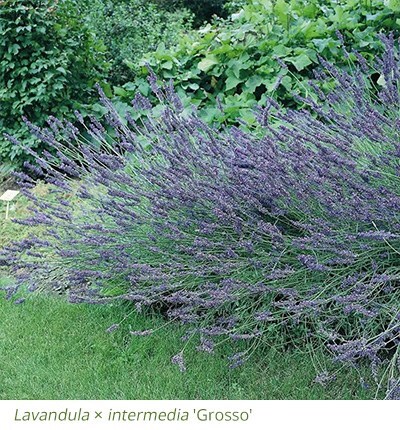 English lavenders, (forms of Lavandula angustifolia), will be over by August but this is a good month to cut them back to almost nothing so that they produce lots of new growth at the base. This helps to keep them vigorous and makes it easier for them to get through winter. Treated like this English lavender could look good for twenty years. The lavendins, (named forms of Lavandula x intermedia), are just getting into their stride though. They differ from the narrow-leaved, upright and short-spiked English lavenders because they have long slender stems topped by tapering heads of flower. These splay out from the foliage, like spines on an anteater, so give them space to shine because they’re very architectural. ‘Grosso’ is the classic lavendin, grown all over Provence for lavender oil, and it has deep purple flower spikes and green foliage. These lavenders are nowhere near as hardy, so the foliage is trimmed back in mid-September, into a rounded mound. Remove a few inches only. English lavenders, (forms of Lavandula angustifolia), will be over by August but this is a good month to cut them back to almost nothing so that they produce lots of new growth at the base. This helps to keep them vigorous and makes it easier for them to get through winter. Treated like this English lavender could look good for twenty years. The lavendins, (named forms of Lavandula x intermedia), are just getting into their stride though. They differ from the narrow-leaved, upright and short-spiked English lavenders because they have long slender stems topped by tapering heads of flower. These splay out from the foliage, like spines on an anteater, so give them space to shine because they’re very architectural. ‘Grosso’ is the classic lavendin, grown all over Provence for lavender oil, and it has deep purple flower spikes and green foliage. These lavenders are nowhere near as hardy, so the foliage is trimmed back in mid-September, into a rounded mound. Remove a few inches only.
Salvias are also highly popular with bees and many will flower until late October. At this stage of the year, when other flowers are few and far between, they will attract hummingbird hawk moths. Among the most hardy is the bright red ‘Royal Bumble’ a woody compact salvia that has black buds to enhance those post-office box red flowers. This will overwinter if given a dry and warm position.
Hardier salvias tend to have quite small lipped flowers in pink and red, but the showier dark blues are only frost hardy. They make excellent container plants - although most of you will need to take them in during winter. Salvia guaranitica 'Black and Blue’ and ‘Amistad’ provide wands of deep-blue flowers held in black bud cases. Bumble bees with long tongues drink the nectar but shorter-tongued bees, unable to reach the nectar, bite into the back instead.
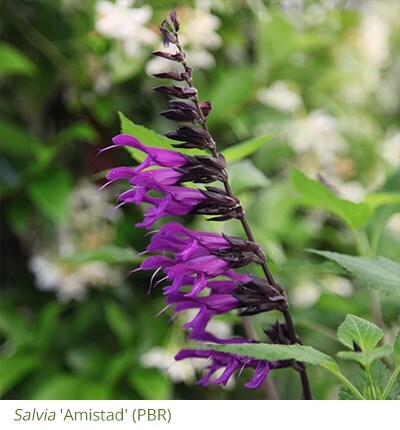 The Wish Series of salvias, which aren’t hardy at all, are perfect for containers because they won’t survive the winter outside. Bring them in and keep them slightly moist, or take cuttings. ’Wendy’s Wish’ is a deep pink to magenta with beetroot-red stems. ’Ember's Wish’ has coral-orange flowers and ‘Love and Wishes’ has reddish purple flowers. All will flower on into November in clement years and bumble bees will still be foraging. The Wish Series of salvias, which aren’t hardy at all, are perfect for containers because they won’t survive the winter outside. Bring them in and keep them slightly moist, or take cuttings. ’Wendy’s Wish’ is a deep pink to magenta with beetroot-red stems. ’Ember's Wish’ has coral-orange flowers and ‘Love and Wishes’ has reddish purple flowers. All will flower on into November in clement years and bumble bees will still be foraging.
Southern hemisphere plants, such as salvias and penstemons, respond to evenly balanced days so they come into their own as the days shorten. Penstemons flower until late and one the most flower-packed is 'Andenken an Friedrich Hahn’, a wine-red heritage Swiss-bred variety that’s far hardier than many. Other tried and tested penstemons include the very prettily marked ‘Hidcote Pink’ and the white-throated pink ‘Apple Blossom’. The handsome purple-blue ‘Sour Grapes’, which has greyer foliage that most, is a statuesque penstemon quite unlike the others. The Pensham Series are recently bred and 'Pensham Plum Jerkum’ is said to be the same colour as a Worcestershire liqueur made from plums. It’s dark flowers have a touch of white, to guide the bee to heart of the flower, and this dash of white stops it looking sombre.
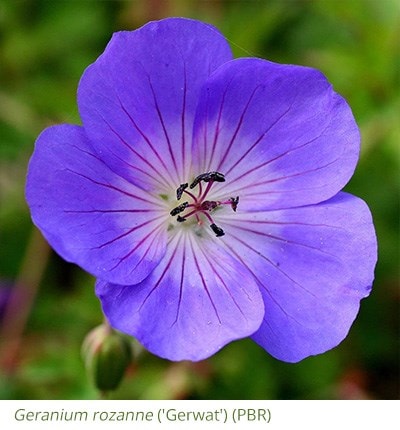
Spires are good news for bees as well, because they offer lots of flowers on the same stem and these open in sequence. They also break up the monotony of a border which tends to rely on humps and roundels. Veronicastrums deserve to be grown more widely, for their rocket-like flowers. ‘Fascination’ is a warm lavender-mauve that sometimes develops flattened stems, a thing known as fasciation. I have often speculated about Fascination’s name, with - is it wordplay on fasciation? ‘Lavendelturm’ is taller, getting up to 6ft, but rarely needs staking and it’s slightly later. ‘Adoration’ is a slightly shorter lilac-pink. All will mix well with taller grasses such as Miscanthus sinensis and the flowers fade well too, leaving a pointed seed head.
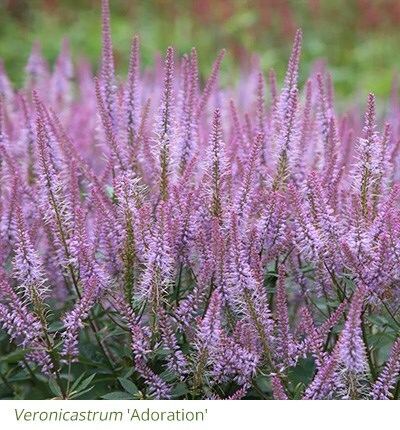 Verbenas are shorter, but similar, and the tiny pink flowers of Verbena hastata ‘Rosea’ make late summer and early autumn special because the dark branching stems, almost candelabra like, are clothed in dark buds that open to produce small pink flowers that sparkle in a border like flecks of colour. It’s dainty, yet architectural, reaching three feet in height and it reputedly self seeds. Verbenas are shorter, but similar, and the tiny pink flowers of Verbena hastata ‘Rosea’ make late summer and early autumn special because the dark branching stems, almost candelabra like, are clothed in dark buds that open to produce small pink flowers that sparkle in a border like flecks of colour. It’s dainty, yet architectural, reaching three feet in height and it reputedly self seeds.
August and late summer are dominated by the daisy and luckily all daisies are bee friendly because the middle of the flower is packed with tiny flowers - each with a nectary underneath. The tall lemon-yellow sunflower, Helianthus Lemon Queen’ is a long-lived perennial of great beauty with good green foliage and single cool yellow flowers. It will make large clumps and, at 5ft or more, it needs space. The ultimate partner is wine-red eupatorium, (or Joe pye weed). It matches it in height and flowers at exactly the same time. Eupatorium maculatum (Atropurpureum Group) 'Riesenschirm' has purple-red heads of fluffy flowers, like storm clouds in evening light, and makes the perfect foil for those cool lemon daisies.
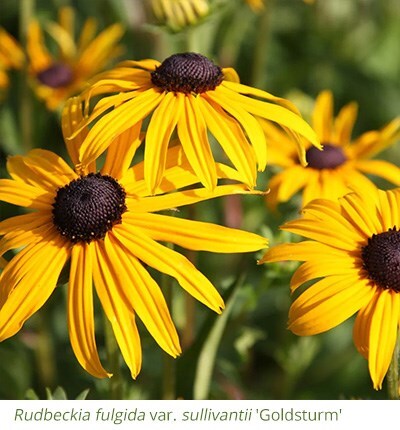 If you want long-lasting crisp yellow daisies, with brown middles, the perennial rudbeckias oblige and flower over many weeks. They form gentle rounded clumps and the dark green foliage always looks equally handsome. Known as black-eyed Susans, the crispest flowers belong to Rudbeckia fulgida var. deamii but Rudbeckia fulgida var. sullivantii ‘Goldsturm' is also excellent. Team either with a lavender-blue European hybrid aster called Aster x frikartii ‘Mönch' because they are both similar heights, about 90 cms, and both flower over many weeks. If you want long-lasting crisp yellow daisies, with brown middles, the perennial rudbeckias oblige and flower over many weeks. They form gentle rounded clumps and the dark green foliage always looks equally handsome. Known as black-eyed Susans, the crispest flowers belong to Rudbeckia fulgida var. deamii but Rudbeckia fulgida var. sullivantii ‘Goldsturm' is also excellent. Team either with a lavender-blue European hybrid aster called Aster x frikartii ‘Mönch' because they are both similar heights, about 90 cms, and both flower over many weeks.
Another easy aster with the same lavender-blue presence is Symphyotrichum 'Little Carlow’. It makes a substantial bush of fine foliage and the small buds have a diamond pattern edged in red before the little starry flowers appear. Moths, butterflies and bees will descend and this aster doesn’t get shabby foliage. It’s as crisp as the rudbeckia.
|










